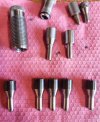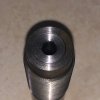Making a .224 push thru sizer today. Forgot just how much I hate them. That tiny little hole is a bitch to bore and no better to polish to size.
First one ended up .225. No big loss, I will just get rebored to something bigger in the future.
I may look at a design change to make it more practical to make.
Mitty, his thing is gonna be right or I won’t mail it to you.
First one ended up .225. No big loss, I will just get rebored to something bigger in the future.
I may look at a design change to make it more practical to make.
Mitty, his thing is gonna be right or I won’t mail it to you.


